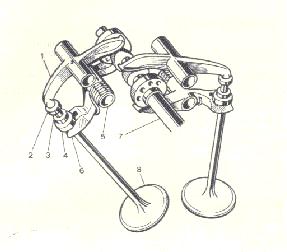

This picture is of the two valve head design. The four valve design is less elegant, but has more effecient in use of space. Aside from removing the rear shock to get to the 91-98 Supersport's rear cylinder's exhaust valve, it is a routine affair. The design is very artistic to see, and certainly, looks less like a machine than the valve train in any Japanese motorcycle. Maybe this is why the Ducatis are so fast! For the non-Ducatisti (and those who didn't notice in the picture above), the desmo design doesn't use valve springs to close the valve, instead using another rocker arm (and cam lobe) to push the valve closed. This eliminates valve float, and was originated by Mercedes in the 50's when mettallurgy and technology made for weak valve springs and bent valves.
Some naysayers call the helper spring in the drawing above (scanned from the owner's manual, page 20, 900 Supersport) a valve spring, but that spring is to aid in starting. This way, it doesn't take two or three revolutions to start the engine. I found out for myself that without these helper "return" springs, the 2V engine doesn't really like idling. It also seemed to make a little valve clatter without the springs.
As far as the desmo design goes... I've had much confirmation that Mercedes was the first to produce engines with desmo valves (at least for road vehicles). One-off examples don't really count. :) Someone said that ships had them earlier, but I'd need some confirmation of that to not say that Mercedes did it first.
Who knows what kind of stuff ships would have? They've got all sorts of goofy configurations for power plants. vertically opposed with the crank in the middle. Others with the combustion chamber in the middle and cranks top and bottom. My bro was on a ship with a Hundai six cylinder. 2.9m stroke with a .6m bore and 2700 hp per cylinder. It's a 2 stroke turbocharged diesel that turns at 90 - 100 rpm and stands only 2 stories tall.